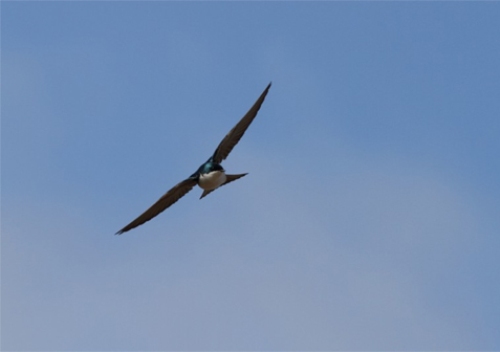|
|
THIS WEEK |
THIS SPRING |
2011 TOTAL |
SITE TOTAL |
|
# birds (and species) banded |
- |
- |
71 (8) |
31640 (107) |
|
# birds (and species) repeat |
- |
- |
8 (1) |
5515 (68) |
|
# birds (and species) return |
- |
- |
24 (2) |
831 (37) |
|
# species observed |
38 |
49 |
58 |
202 |
|
# net hours |
- |
- |
23 |
49640.1 |
|
# birds banded / 100 net hours |
- |
- |
308.7 |
63.7 |
|
|
Note: table does not include nocturnal banding (owls) |
Banders-in-charge: Simon Duval, Gay Gruner
Assistants: Jean Demers, Gay Gruner, Malcolm Johnson, Louise LeBel, Barbara MacDuff, Daniel Martin, Betsy McFarlane, Chris Murphy, Greg Rand, Catherine Russell, Clémence Soulard, Rodger Titman.
Notes: This was the third and final week of our "early spring" phase, during which we conduct census daily and take care of various site maintenance tasks, but don't yet open up any of the nets for banding. The frogs have started to sing, pussy willows (Salix discolor) are in their furry stage, and the Tree Swallows have begun to return, so it must be spring. However, temperatures dropped toward the end of the week and seemed to temporarily shut off the tap on new migrants. Before the cold front moved in, we recorded seven new species for the season: Red-shouldered Hawk, Red-tailed Hawk, Merlin, Yellow-bellied Sapsucker, Tree Swallow, Fox Sparrow, and Swamp Sparrow; all of these except Red-tailed Hawk were also new sightings for the year. Also of note, we have regularly been seeing three deer when opening the gate in the morning - although nice to see, we hope they won't be moving around the site once the nets are open next week. In preparation for the banding season, we put up all the nets this week, with many thanks to Jean Demers, Catherine Russell, Clemence Soulard, and Matthew Von Bornhoft for their help.
This week’s
top 10
#
individuals banded |
mean # individuals observed daily |
- |
1. Canada Goose (52) [1] |
- |
2. Red-winged Blackbird (43) [4] |
- |
3. Slate-colored Junco (18) [-] |
- |
4. American Crow (16) [9] |
- |
5. American Robin (12) [8] |
- |
6. Song Sparrow (11) [-] |
- |
7. Bohemian Waxwing (10) [3] |
- |
7. Black-capped Chickadee (10) [9] |
- |
9. Wood Duck (9) [7] |
- |
9. Ring-billed Gull (9) [4] |
|
Eight of the species in this week's top ten were also on last week's list, although there has been some shuffling of ranks. Slate-colored Junco jumped back on after dropping out last week, while Song Sparrow made it to the top ten for the first time this year, likely on the strength of returning local residents. Displaced from last week's list were Cedar Waxwing and Snow Goose. Canada Goose was again the most abundant species, although overall numbers were down 90% since last week, and only around 20% of what the six-year average is for this time of year. This is the sixth time in our seven spring seasons that Canada Goose has taken top spot in week 3; only last year was an exception to this pattern. Red-winged Blackbird numbers are somewhat above average for this time of year, though not as high as the record of 57 back in 2006. The juncos were even more unusually common for week 3, having only appeared in this week's top ten twice in the previous six years. Also of note, we've never before had more than a couple of Bohemian Waxwings stick around this late in spring, so although numbers did taper off this week, we're hoping there's a chance a few might linger into next week and perhaps give us a chance at finally banding our first one.
|

Water levels are extremely high this spring, thanks to heavy rainfall late last fall and an above-average volume of snow over the winter that has only recently melted. The "pond end" of net H1 is still well below water at this point, and we probably won't be able to use the net for at least another week or two, but we installed it all the same so that we're ready to go once the pond level drops. Here Jean Demers (right) and our spring intern Matthew Von Bornhoft have waded into the pond to get the work done - the water was deep enough to overflow the top of Matthew's rubber boots, so he took them off, rolled up his pants, and went back in barefoot!
(Photo by Gay Gruner)

Another spot with flooding problems was the census trail past the end of the "C" nets. This boardwalk was completely underwater at the start of the week, but thanks to Gay Gruner, Malcolm Johnson, and Matthew Von Bornhoft digging a 25-cm deep trench to install a plastic culvert underneath, which got this temporary creek under control.
(Photo by Gay Gruner)
|



